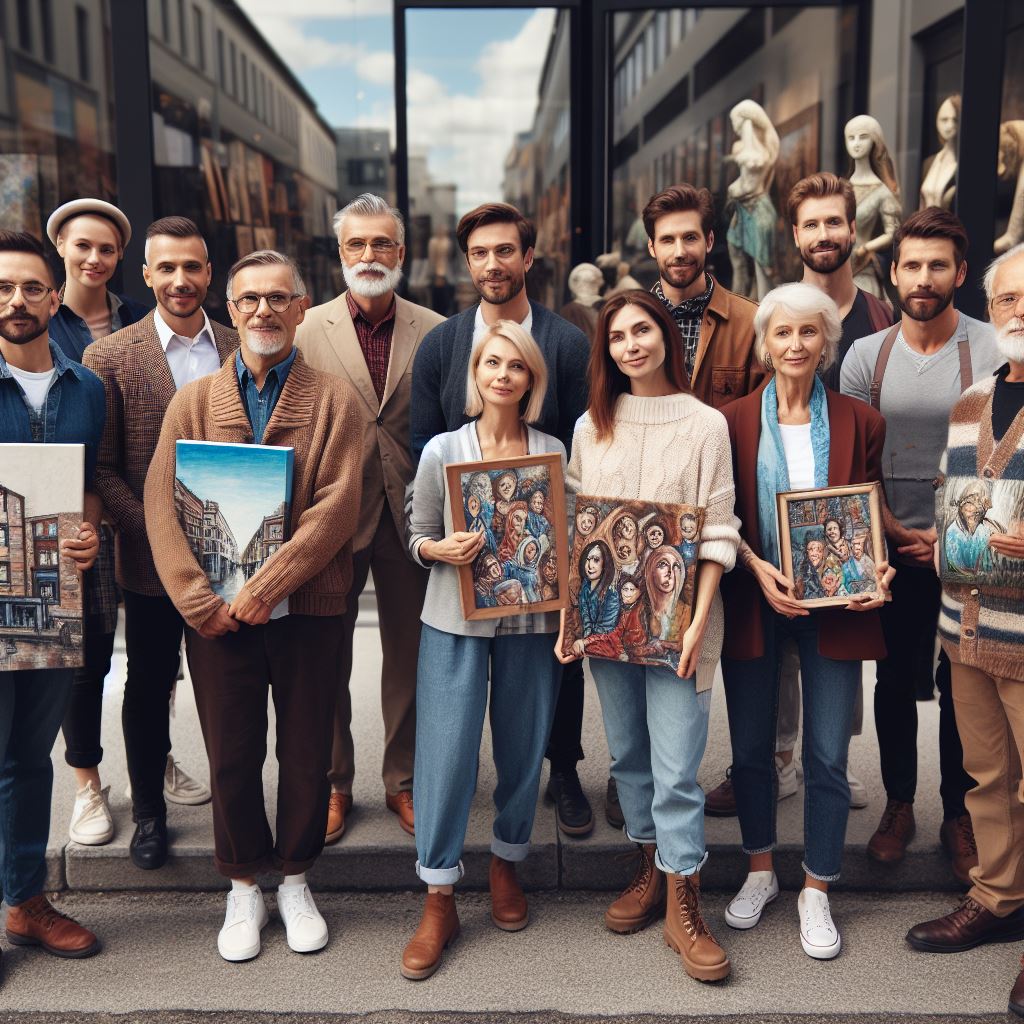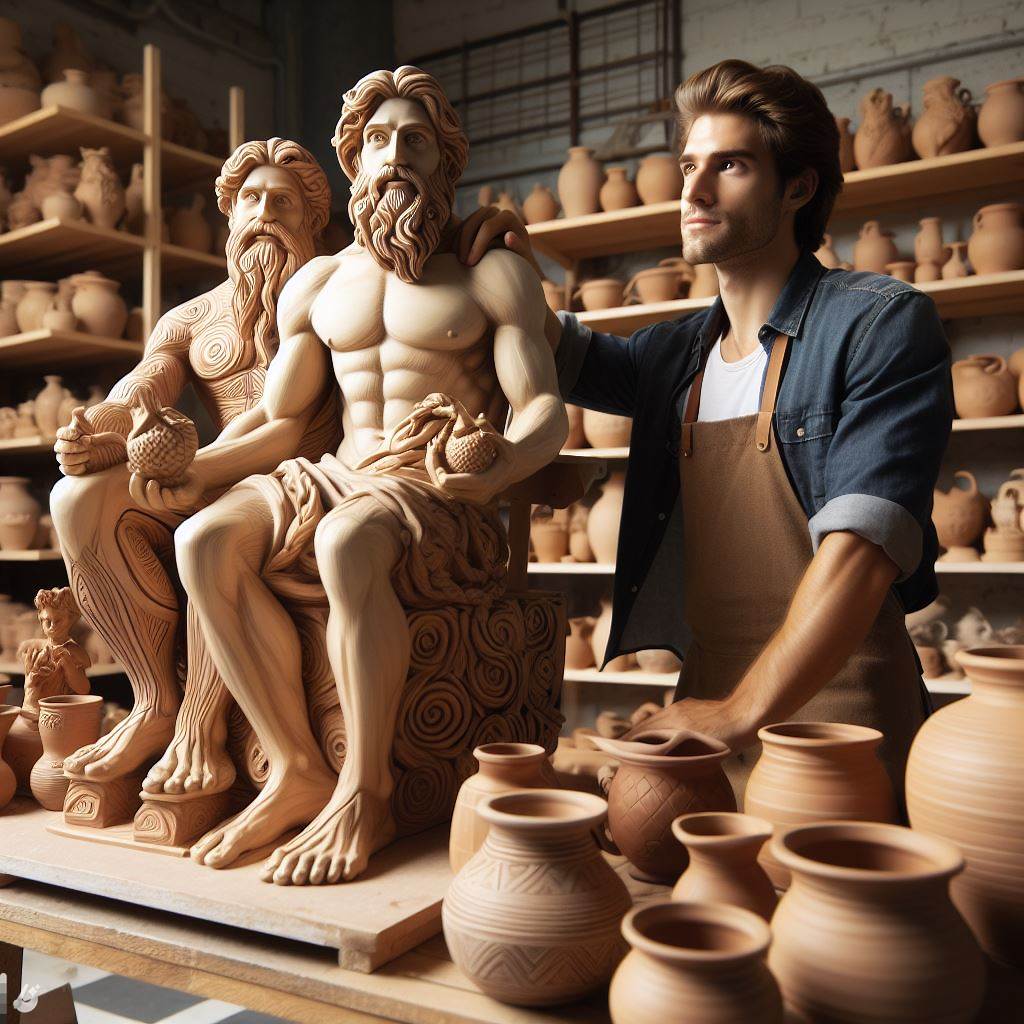Introduction
Starting an art career in Canada is an exciting but challenging journey that many aspiring artists embark on.
Breaking into the industry is crucial for success, but it can be filled with obstacles and hurdles to overcome.
Artists entering the Canadian art scene must navigate through a competitive landscape, where standing out is essential.
The importance of making a mark and gaining recognition cannot be overstated.
Without breaking into the industry, artists may struggle to gain exposure and find opportunities to showcase their work.
However, it is important to acknowledge the potential challenges that artists may face on their path to success.
Limited resources, financial struggles, and a saturated market are just a few obstacles that artists encounter.
Additionally, the lack of support and mentorship available can hinder their progress.
Despite these challenges, the rewards of a successful art career in Canada can be immeasurable.
Establishing a strong network, seizing opportunities, and consistently honing one’s craft are vital steps towards breaking into the industry.
Throughout this blog section, we will explore various strategies and tips to help aspiring artists carve their path in Canada’s art industry.
From building a portfolio to networking effectively, we will provide valuable insights and practical advice to help artists thrive in this competitive field.
So, let’s dive into the world of starting an art career in Canada and learn how to overcome the challenges and embrace the opportunities that await!
Understanding the Canadian Art Scene
When it comes to the art scene in Canada, diversity and vibrancy are the key characteristics.
Diversity and Vibrancy of the Canadian Art Scene
Canada’s art scene is a melting pot of cultures and influences, making it incredibly diverse.
Artists from various backgrounds come together to create a rich tapestry of styles and forms.
From traditional indigenous art to contemporary works, there is something for everyone in Canada.
This diversity brings a vibrant energy that permeates throughout the Canadian art community.
Different Art Forms and Styles Prominent in Canada
Canada is home to a wide range of art forms and styles, showcasing the artistic talent within the country.
Painting and sculpture are among the most prevalent forms, with many artists excelling in these mediums.
The use of mixed media is also popular, allowing artists to experiment and push boundaries.
Photography, printmaking, and installation art are other forms that have gained significant recognition.
Examples of Celebrated Canadian Artists
- Emily Carr: Known for her vibrant landscapes and paintings inspired by Indigenous cultures.
- Lawren Harris: A member of the famed Group of Seven, known for his iconic Canadian landscapes.
- Jeff Wall: Known for his large-scale photographs that blur the line between reality and fiction.
- Shelagh Keeley: A renowned installation artist whose works explore themes of memory and identity.
- Doris McCarthy: Celebrated for her distinctive Canadian landscape paintings and love for nature.
- Rebecca Belmore: A renowned performance and installation artist who addresses political and social issues.
These are just a few examples of the many celebrated Canadian artists who have made a significant impact.
Their works serve as an inspiration for aspiring artists looking to make their mark in Canada.
Overall, the Canadian art scene is a vibrant and diverse community, welcoming artists from all walks of life.
Unlock Your Career Potential
Visualize a clear path to success with our tailored Career Consulting service. Personalized insights in just 1-3 days.
Get StartedThe range of art forms and styles provide endless opportunities for artists to explore their creativity.
By understanding the Canadian art scene, aspiring artists can better navigate their way into a successful art career in Canada.
Read: The Future of Writing Careers in Canada
Developing Your Artistic Skills
Continuously improving your artistic abilities is crucial for starting a successful art career in Canada. Here are some recommendations:
Enroll in Art Classes or Workshops
- Investing time and effort in formal art education can greatly enhance your skills.
- Look for reputable art schools or community centers that offer classes or workshops.
- Interacting with fellow artists and receiving feedback from instructors can be invaluable.
Explore Different Mediums and Techniques
- Experiment with various artistic mediums such as painting, drawing, sculpture, or digital art.
- Each medium has its own unique challenges and learning them can broaden your artistic range.
- Try different techniques within your chosen medium to develop your own style and voice.
Attend Art Exhibitions and Galleries
- Immerse yourself in the art world by visiting exhibitions and galleries in your area.
- Observe and analyze the works of established artists, studying their techniques and styles.
- Attend artist talks or gallery openings to connect with other artists and gain inspiration.
Seek Critique and Feedback
- Share your artwork with friends, family, or fellow artists to receive constructive criticism.
- Constructive feedback can help identify areas for improvement and refine your artistic skills.
- Join art communities or online forums where you can share your work and engage in critique.
Practice Regularly
- Developing your artistic skills requires consistent practice and dedication.
- Set aside specific time each day or week to work on your art, treating it like a professional commitment.
- Practice different techniques, experiment with new ideas, and push yourself out of your comfort zone.
Keep Learning and Evolving
- Artistic skills are not stagnant, so continue learning and evolving throughout your career.
- Take advantage of online resources, art blogs, books, or podcasts to expand your knowledge.
- Attend workshops or conferences to learn from industry professionals and stay updated with new trends.
Developing your artistic skills is a lifelong journey that requires continuous effort, exploration, and learning.
Enroll in classes and workshops, experiment with various mediums and techniques, seek critique, regularly practice, and stay open to learning new things.
Embracing this mindset will undoubtedly contribute to your success in starting an art career in Canada.
Read: Building Your Brand as a Writer in Canada
Building a Portfolio
In the world of art, having a strong and cohesive portfolio is essential for starting a successful career.
Your portfolio showcases your skills, creativity, and unique style to potential clients and employers.
It is a representation of your artistic journey and a tool to make a lasting impression. Here are some important factors to consider when building your portfolio:
Importance of a Strong and Cohesive Portfolio
- A strong portfolio demonstrates your talent and expertise in various artistic mediums.
- It reflects your growth and development as an artist over time.
- A cohesive portfolio shows consistency and a clear artistic identity.
- It helps you stand out from other artists and leaves a memorable impression on viewers.
Tips for Selecting and Presenting Artwork
- Choose your best and most representative artwork to include in your portfolio.
- Showcase a variety of techniques, subjects, and styles that highlight your versatility.
- Avoid including too many pieces to prevent overwhelming the viewer.
- Consider the target audience and tailor your portfolio accordingly.
- Arrange your artwork in a visually appealing and logical order, telling a story or conveying a theme.
- Include high-quality photographs or scans of your artwork to ensure clarity and accuracy.
- Provide concise descriptions or artist statements for each piece to give context and insight.
Different Formats to Consider: Physical and Digital Portfolios
There are multiple formats to consider when presenting your portfolio:
- Physical Portfolio: This traditional format involves creating a physical collection of your artwork in a binder, portfolio case, or folio.
- Digital Portfolio: With technological advancements, many artists now opt for digital portfolios. These can be accessed online through websites, social media platforms, or specialized portfolio hosting services.
Both formats have their advantages. Physical portfolios allow for a tactile experience, showcasing the craftsmanship and texture of your artwork.
They are ideal for in-person meetings and interviews.
On the other hand, digital portfolios offer convenience, easy accessibility, and the ability to reach a broader audience. They also allow for more interactive elements, such as video clips or animations.
It is important to consider your target audience, goals, and personal preference when choosing between physical and digital formats.
Some artists even create a combination of both, using physical portfolios for specific occasions and maintaining an online version for wider exposure.
Remember, building a portfolio is an ongoing process. Continuously update and refine your portfolio as you create new artwork and gain experience.
Seek feedback from trusted mentors or professionals in the art industry to improve and ensure the effectiveness of your portfolio.
With a well-crafted portfolio, you will be ready to showcase your talent and embark on a successful art career in Canada.
Read: Canadian Writers’ Legal Rights Explained
Networking and Collaboration
Networking and establishing connections in the art community are invaluable for starting an art career in Canada.
These connections can open doors, create opportunities, and provide support and guidance.
Here are some suggestions for attending art events, exhibitions, and festivals:
- Research and identify local art events and exhibitions happening in your area.
- Attend openings and artist talks to meet fellow artists, curators, and art professionals.
- Participate in art workshops, classes, or residencies to connect with like-minded creatives.
- Utilize social media platforms to follow and engage with local artists, galleries, and art organizations.
- Join art associations, online forums, and mailing lists to stay updated on art-related news and opportunities.
- Attend art conferences, symposiums, or panel discussions for insights into the art industry and to network with professionals.
- Volunteer at art festivals or exhibitions to gain hands-on experience, make connections, and learn about the local art scene.
Collaborating with other artists and creatives can have numerous benefits
- Sharing ideas, techniques, and perspectives can spark creativity and inspire new ways of thinking.
- Collaboration allows for the pooling of resources and skills, enabling the realization of ambitious and large-scale projects.
- Working with others fosters a supportive and inclusive community, providing emotional and professional encouragement.
- Collaborative projects can attract more attention and increase exposure by tapping into different networks and audiences.
- Collaboration can lead to cross-disciplinary exploration, resulting in the development of new skills and innovative artworks.
- Partnering with other artists can help navigate the art industry, share knowledge, and create mentorship opportunities.
In short, networking and collaboration play a vital role in starting an art career in Canada.
Attending art events, exhibitions, and festivals, as well as collaborating with other artists and creatives, can provide valuable connections, support, and opportunities.
Embrace the art community and establish meaningful relationships to enhance your artistic journey.

Finding Opportunities
When it comes to starting your art career in Canada, finding opportunities is essential.
Here are some tips and ideas on how to research and identify art opportunities in the country:
Explore Art Galleries, Museums, and Public Art Programs
- Visit art galleries and museums in your area to learn about upcoming exhibitions and shows.
- Research public art programs in Canada, as they often offer opportunities for artists to showcase their work.
Be Open to Artist Grants, Residencies, and Competitions
- Look for artist grants and scholarships that are available to Canadian artists. These can provide financial support to help you pursue your artistic endeavors.
- Research artist residencies in Canada, which allow artists to work and live in a creative environment for a specific period of time.
- Consider entering art competitions and contests. Winning or being recognized in these competitions can boost your career and provide valuable exposure.
It is important to remember that finding art opportunities requires proactive research and networking. Here are a few additional tips to help you in your search:
Join Art Associations and Organizations
- Consider becoming a member of local or national art associations and organizations. These groups often provide resources, networking opportunities, and information on art opportunities.
Attend Art Events and Workshops
- Participate in art events, workshops, and artist talks. These events are not only educational but also provide a chance to connect with other artists and industry professionals.
Use Online Platforms
- Explore online platforms dedicated to promoting art opportunities, such as artist residency directories, art competition websites, and online art marketplaces.
- Utilize social media platforms such as Instagram and Facebook to follow art organizations, galleries, and artists. They often post about upcoming opportunities and events.
Lastly, don’t underestimate the power of networking. Connect with other artists, curators, and professionals in the art industry.
Attend exhibition openings, art fairs, and networking events to expand your circle and stay informed about potential opportunities.
Remember, finding art opportunities requires persistence, research, and a proactive approach.
Stay motivated, keep creating, and seize every opportunity that comes your way. Good luck!
Read: Cultural Diversity in Canadian Acting Scene
Navigating the Art Market and Business Side
Understanding the art market is crucial for aspiring Canadian artists, enabling informed career decisions about pricing, commissions, and representation.
To gain insights:
- Visit art galleries and exhibitions for trends, prices, and buyer preferences.
- Participate in art fairs and trade shows to interact with buyers and understand market demands.
- Explore online platforms for a global audience and gauge market demand beyond Canada.
- Read art publications and watch documentaries for knowledge about the art market and successful paths.
- Attend workshops and courses for practical skills in marketing, pricing, and contract negotiations.
- Join professional associations like the Canadian Artists Representation for networking and resources.
- Seek mentorship from experienced artists or professionals for personalized advice and insights.|
- Understand financial concepts for effective finance management and intellectual property protection.
- Explore government grants and programs supporting artists in building their businesses.
- Attend networking events to connect with collectors, curators, and gallery owners for collaborations and opportunities.
By utilizing these resources actively, artists can navigate the Canadian art market and make informed career decisions.
Read: Canadian Actor Tax Tips: Managing Finances
Promoting Your Artwork
Effective self-promotion plays a crucial role in establishing a successful art career.
With a competitive art industry, it is essential to showcase your talent and make your work known to a wider audience.
There are several strategies you can employ to promote your artwork:
Utilize Social Media Platforms and Artist Websites
- Social media platforms like Instagram, Facebook, and Twitter can help you reach a larger audience.
- Create professional artist profiles and regularly share high-quality images of your artwork.
- Engage with your followers by responding to comments and building connections with potential buyers or fellow artists.
- Consider creating your own artist website to serve as a hub for your portfolio and to provide information about your artistic journey.
- Showcase a variety of your artwork on your website and make it easy for visitors to contact you for inquiries or purchase.
Participate in Art Shows and Online Marketplaces
- Art shows and exhibitions offer an excellent opportunity to display your artwork to a targeted audience.
- Research and apply to local art shows, galleries, and events that align with your artistic style.
- Prepare a professional portfolio and attend these shows to network with potential buyers, collectors, and industry professionals.
- Consider participating in online marketplaces such as Etsy, Saatchi Art, or Artfinder to reach a global audience and sell your artwork online.
- Regularly update your online listings with high-quality images and detailed descriptions to attract potential buyers.
By participating in multiple art shows and online marketplaces, you increase your chances of gaining exposure and selling your artwork.
Collaborate with Other Artists and Art Organizations
- Collaborating with other artists can lead to mutual promotion and increased visibility.
- Consider partnering with artists whose style complements yours for joint exhibitions or online projects.
- Connect with local art organizations, art clubs, or artist associations to find opportunities for collaboration and exposure.
- Art organizations often host group exhibitions, workshops, or competitions that can help you gain recognition.
- Attending art-related events and networking with fellow artists can provide valuable insights and connections.
Build an Email List and Send Newsletters
- Building an email list allows you to communicate directly with your audience, including art enthusiasts, collectors, and previous buyers.
- Offer incentives like exclusive discounts or previews of new artwork to encourage people to subscribe to your newsletter.
- Regularly send newsletters to your subscribers, showcasing your latest artwork, upcoming exhibitions, or any other relevant news.
- Include links to your online platforms and encourage recipients to share your newsletter with their networks.
- Building a loyal email following helps to establish a strong connection with potential buyers and ensures they stay updated on your artistic journey.
Promoting your artwork requires consistent effort and strategic planning.
Embrace opportunities to showcase your talent and leverage the power of social media, art shows, collaborations, and email marketing.
By actively promoting your artwork, you increase the chances of success in the competitive Canadian art industry.
Read: Creating Your Brand as a Canadian Actor
Find Out More: Art and Technology: Canadian Artists Innovating
Conclusion
In closing, starting an art career in Canada requires determination, passion, and the willingness to take the necessary steps.
We discussed the importance of building a strong portfolio, networking with other artists and art organizations, and finding opportunities for exhibition and sales.
It is crucial for aspiring artists to have a clear vision and set goals for their artistic journey.
Despite the challenges that may arise, I encourage all aspiring artists to pursue their dreams and not be afraid to take risks.
Canada offers a vibrant and supportive art community, filled with opportunities for growth and success.
Remember to stay focused, continue learning and improving your craft, and never stop creating.
Starting an art career in Canada can be a fulfilling and rewarding experience.
Embrace the journey, surround yourself with like-minded individuals, and always stay true to your unique artistic voice.
With dedication and perseverance, you can build a successful art career in Canada and make a meaningful contribution to the vibrant art scene in the country.
Good luck on your artistic endeavors!




